Things start to roll in the 30s
Don Martinez started the first fly shop in West Yellowstone in 1931 or so, which later became the Pat Barne's Fly Shop and later still Bob Jacklin's Shop, still a good going concern today.
Don Martinez' favorite flies were classic Catskill dry flies according to George Grant, but Don's career is most notably associated with his popularization of an old Ozarks bass fly which eventually became known as the Woolly Worm. The Martinez Black Nymph was an important historical milestone too. Nymphs are a vast lexicon now but they weren't at all that way in 1931. The Martinez Black Nymph caught on quickly and became quite popular. At least in West Yellowstone. The Martinez Black Nymph is an important fly. I'll talk more in a section about Matching the Behahvior.
Woolly Worm
When I first moved to Montana as a 27 year old with my wife, four year old daughter, dog, 3/4 ton Chevy pickup (that ran on propane) and $300 in dollars cash I earned rough-knecking on the oil rigs in Northern Colorado--I knew this was going to be good. I already knew how to fish and this was right where I wanted to be. Trouble is I was a young broad-shouldered house framer with a dark suntan and a long right arm. And the only thing I knew how to fish were dry flies in Summer. And that's when I had to work, seven days a week in those days. I had a family to feed.
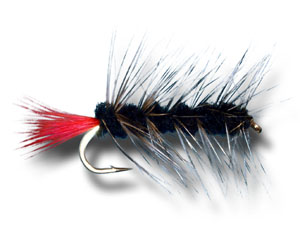
I couldn't help noticing the big fish pictures in the Bozeman Daily Chronicle. A few good fish got caught in late October and early November every year. But most of the big fish--by far--all seemed to get caught in March and April. Good dry fly midge fishing can be had in March in Montana but I didn't know about it then. Baetis hatch in April too and then again in October, but once again I hadn't found out about them yet either. I finally realized I was an enthusiastic tourist who didn't know feces from shoe polish about Montana fly fishing. In March everybody I knew out in the subdivision wars caught fish on spinners salmon eggs and worms. Or on Woolly Worms. Which gave me an idea.
I made a quick attitude adjustment and started tying and fishing Black Woolly Worms. Like a demon. It wasn't hard. I started catching fish, big fish, almost immediately. I was still married to Matching the Hatch ideas in those days so I eventually started tying my Woolly Worms with the saddle hackle only up front, so they looked more like a real stonefly nymph I thought. I But in retrospect it didn't seem to make any difference.
On one April walk/wade near the mouth of the Gallatin Canyon with my old and now departed friend John Wilson we decided to have a contest. I think I ended up with 27 fish and John with something like 32. I fished one of my signature brown hackle up front only Woolly Worms all day. i'm not sure about John. I think he had a George's Brown Stone on for at least part of the day. Competing with John on anything related to fishing turned out to be a bad idea, but I didn't know that then. We had just met.
Even so I almost pulled it out. On a Black and Grizzly Woolly Worm I hooked a rainbow over 25" inches long. He jumped clear out of the water twice and then landed on the leader and was gone. When I told John about that fish he cocked his chin sideways, smiled and held one eye half closed as I spoke. But still. I know what I saw. One of the best fish I've ever hooked took a Woolly Worm. Damned good fly. Then and now.
Martinez Black Nymph
Don Martinez did have at least one other notable fly: his Martinez Black Nymph which Pat Barnes continued to tie on into the 1960s. Pat didn't stock his bins with the Martinez Black Nymph or talk about it much but he did tie them and fish with them frequently. Pat's guides in those days referred to the mysterious Black Nymph as the "Patulated Nymph." It's possible they didn't know the Martinez connection. I'll get back to the Martinez Black Nymph in a later section about Matching the Behavior. This is a good fly.
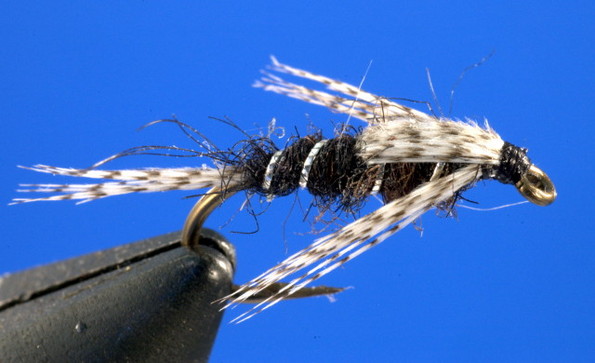
Muddler Minnow
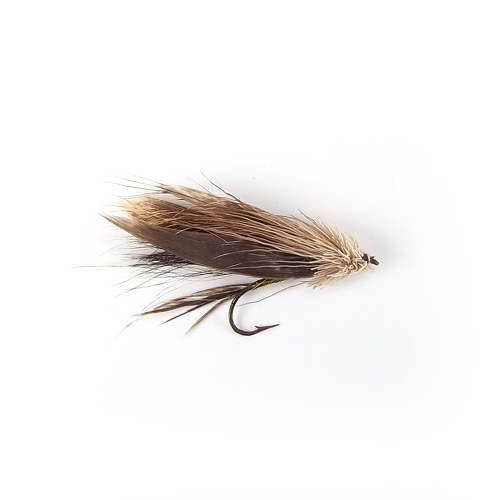
The original Muddler--as tied by Don Gapen himself--was apparently tied with a looser, fuzzier, sparser deer hair head and shoulders than most of the cover variations that followed. Much as I admire if not revere Al Troth, Al popularized Muddlers spun with a tightly packed deer hair head which he carved to a smooth 3d contour with a bent double-edged razor blade. Don Gapen's Muddlers were sparser wider and fuzzier. I personally prefer the older style. Among other things this is primarily a wet fly--a streamer fly--that usually needs to sink in order to do its thing. Densely-packed spun and trimmed deer hair isn't so easy to sink.

It is interesting to note however, the Muddler Minnow does make a powerful dry fly when it does ride the surface. My dad loved to cast them upstream as a dry fly and then to watch his line as the Muddler sunk and swam, across and down after a short float. I once saw a nifty black and white video of Joe Brooks and Dan Bailey casting Muddlers from a tin boat on the Yellowstone on an early Summer day. They cast their Muddlers into the V-shaped pockets below bank side boulders and logs and let them skim back out into the current, on the surface, before twitching and mending after it sank.
For many years many of the best Western fishermen regarded the Muddler Minnow as the best big fish fly going. Muddlers are still sold and used today, now close to a century after their first Northeast Minnesota invention. They don't sell as well as they once did.
Dan Bailey
It's hard to know what to say about Dan Bailey, not because there is so little to say but because there is so much. Dan was a smart as a whip New York City physicist, fly tier and fly fishing buddy of Lee Wullf's who came to Montana in 1938 and never left. He wasn't a businessman by training but he figured it out and became one anyway. Dan was known more as a fly manufacturer and industry pioneer than pattern designer. But he did have a few nifty creations, like the Mossback Nymph, Bi-fly and Marabou Muddler. I try to stay away from Ken Burns like "turning points of history" analyses but Dan Bailey was, if there ever was one, a keystone turning point in Western fly fishing history. After Dan Bailey good quality modern up-to-date flies were suddenly available everywhere. A ball started rolling at that point that's still gaining momentum today.
Girdle Bug
Women's girdles with rubberized elastic fabric became available in the 1920s not long after the end of the first world war. When did clever Yankee fly tiers first start to use those stretchy white rubbery strands in their creative new patterns? There is no definitive answer to that question but many sources attribute the first Girdle Bugs to Anaconda Montana tier Frank McGinnis sometime in the 1930s or 1940s.
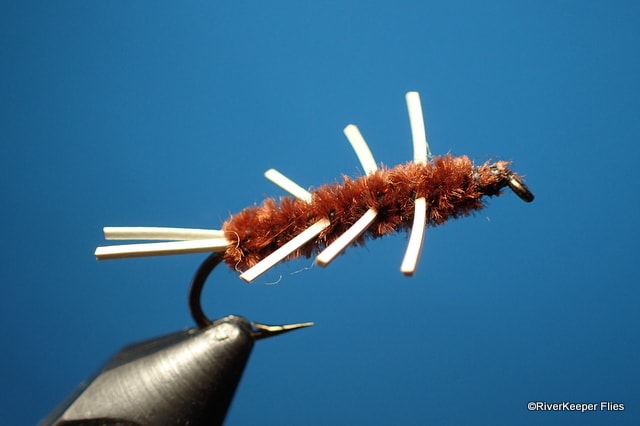
Was the original Girdle Bug black or brown? It's not clear but we do know it had white rubberlegs, at least if as expected it came from somebody's honey's worn out rubberized corset. Or girdle. Somewhat like the later Woolly-Bugger the Girdle Bug is an odd fly that can be fished either as a drifted nymph or as a bank-banging streamer, usually stripped in with short repetitive pulls with the caster's line managing hand.
When I was still married to Matching the Hatch ideology I liked to make Girdle Bugs with brown or better yet mottled or striped brown and black rubberlegs. Walter Weise has a nifty mottled brown legged extended body girdle bug I like the looks of on the Parks Fly Shop website. I'm not saying my old brown legged Girdle Bugs aren't good flies. They are. As is Walter's nifty fly. But the original white legged ones are good flies too even though they don't look like anything real. How do we account for that?
I've gradually and almost thoroughly given up on Matching the Hatch ideology. I now like to think more in terms of "Matching the Behavior," which is a looser term that makes it easier to explain the magic power of the Prince Nymph, Zebra Midge, Royal Wulff and the unnaturally brightly ribbed Gold Ribbed Hare's Ear. More about Matching the Behavior will follow in a later section.
The Girdle Bug was one of Tom Morgan's favorite flies, at least when fishing from a drifting boat. Tom liked to fish the Girdle Bug with a stripping technique he referred to as the Morgan Twitch . I have a good story about the Morgan Twitch.
Tom called me one day and asked if I'd be willing to drive the bus Gus out to a nearby farm pond. Tom had a high roller he was trying to sell one his 7wt glass "Unity With the Universe" streamer rods to. Tom had been telling this guy about the Morgan Twitch and the customer wanted a demonstration before he bought the rod. Tom came along to give instructions. I drove the bus and Tom's son Tim did the casting.
It seemed to take forever to get Tom out of the bus and into his wheelchair and to get everything ready to go. Why I didn't film this episode with my cell phone still escapes me. Tim tied on a Black Girdle Bug and tried his best to demonstrate the Morgan Twitch while Tom gave instructions. But it was almost impossible not to catch an annoying farm pond fish on every cast, which made the Morgan Twitch demonstration difficult.
Tom yelled "Hold the phone!" Tom had Tim switch from a Black and White Girdle Bug to a neon bright Yellow Yummie--a Big Hole River fly that is actually a darned good fly--if and only if the bright yellow marabou it's tied with is heavily mixed with brown, somewhat like a Lyle Reynold's Special--which is similar but more of a Yuk Bug than a Girdle Bug.
Tim immediately stopped catching fish and was able to give us a good demonstration. The Yellow Yummie saved the day. The link above describes it all in greater detail. But in short what Tom did (or had Tim do) was to make a careful splash-free medium distance cast and then to immediately drop the rod tip all the way down to the water. While holding tight to the line Tim slowly and repeatedly raised the rod tip a fair amount and then finished each step by dropping the rod tip ever so slightly in order to dead stop the fly after each strip, so it paused motionless for a few seconds before slowly stripping again. Stripping the fly with the rod tip instead of the left hand made it easier--according to Tom--to set the hook almost instantly, thereby losing fewer good strikes.
Lots of streamer fishermen I know, including myself, often strip steamers quickly, even violently at times. The Morgan Twitch is more of a slow motion finesse move. I use it a lot. I was lucky. I learned it from the horse's mouth.
Bitch Creek
Old timey Montana flies that were once popular that don't get much attention now is a category that definitely includes the venerable Bitch Creek. Not much is known about the origins of the Bitch Creek. George Grant spent a lot of time trying to track down the history and details and he didn't come up with much. The prevailing speculation has the name coming from a tributary of the North Fork of the Teton--named Bitch Creek--that originates in Wyoming but quickly crosses the border into Idaho. Its origination goes at least as far back as the '40s and possibly even older.
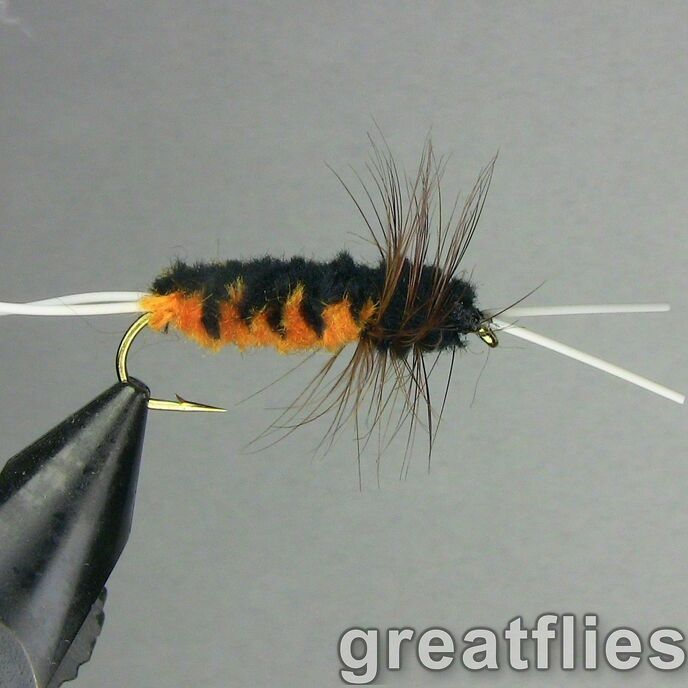
I love the Bitch Creek. It has white rubberlegs combined with an orange and black woven chenille body. Make no mistake. The Bitch Creek is a fish catching son of a gun, even if it isn't a big seller anymore.
The Montana Nymph
For perhaps completely irrational reasons the vaguely similar Montana Nymph is a fly I've never had much confidence in. I prefer my own stonefly nymph imitations and the Bitch Creek. This may not make sense. But so it is. Confidence while fishing with a favorite fly is often a happily self-fulfilling state of affairs, while lack of confidence is perhaps even more strongly self-fulfilling. I've only tied this fly a few times and always seem to reach for the Bitch Creek or one of my own Marshmallow Nymphs instead. So I don't have much to say about it. Others are free to set the record straight.
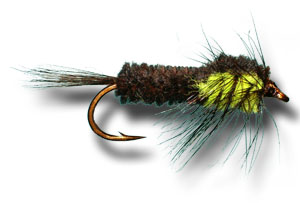
Griffith's Gnat
"Griffith's gnat The Skinny: To this day there are brook trout rising in Michigans Au Sable River in front of George Griffiths cabin, where Trout Unlimited was founded in the 1950s. These fish can be unbelievably picky and there, as elsewhere, this midge pattern is often what fools them. Tied with barred grizzly hackle Palmered over a peacock-herl body, the fly is best in sizes 18 to 22. I cant see it on the water, but when I see a rise where I think the fly might be, I set the hook I " ...whose quote is this? Fix this.
When I'm fishing midges, while fish are actively visibly dimpling in front of me I almost always rely on small perhaps #18 or #20 brassie or other not-weighted chironomid larvae imitation. Sometimes I fish those brassies as a dropper connected to the bend of a Griffith's Gnat hook. The Brassie still catches most of the fish but the Griffith's Gnat makes it easier to keep track of the action. And it always catches a few fish too.
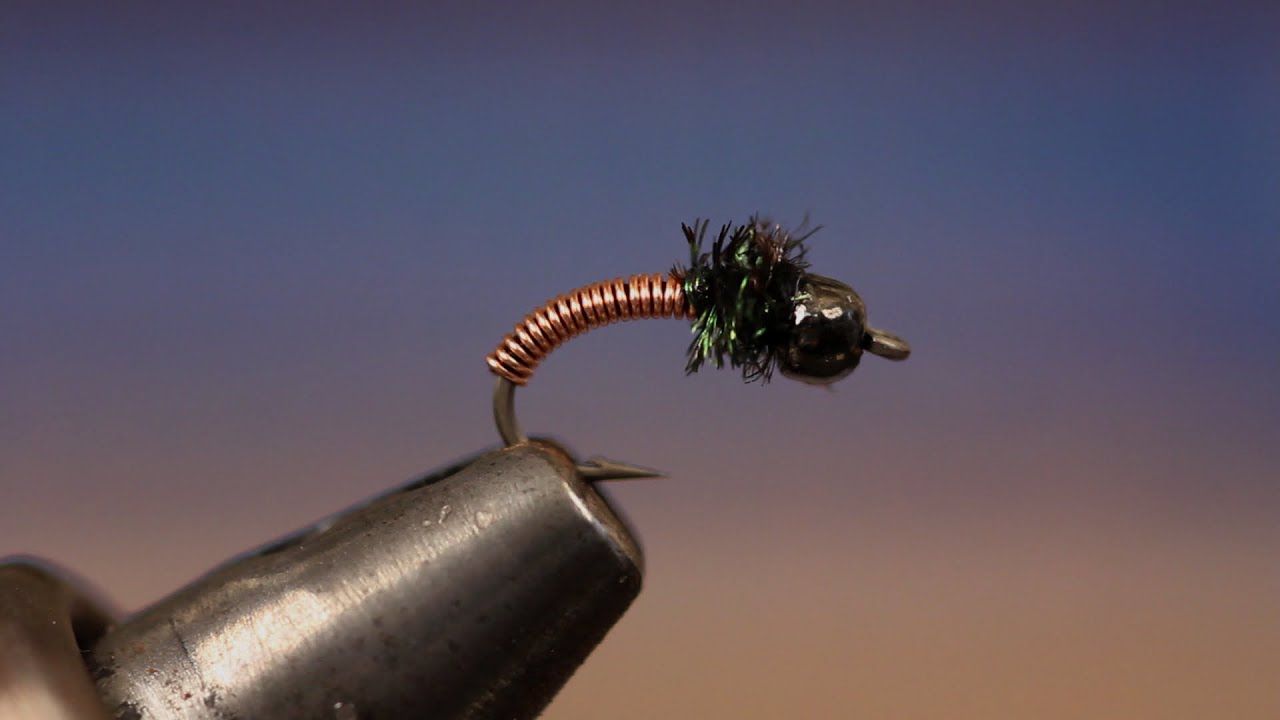
Prince Nymph
The thirties were busy eventful times. The forties were war years and perhaps not so eventful in the fly fishing/fly tying context. So many new important flies appeared during thirties it's hard to catalog them all.
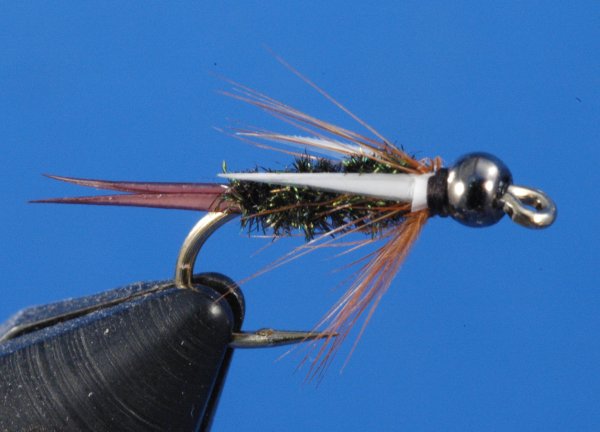
One of the most important of all was Californian Doug Prince's Black Forked Tail Nymph, which later morphed into the iconic Prince Nymph. What are the most successful Western flies of all time? The Western GOAT list may or may not include the Muddler and the Parachute Adams. It definitely includes Lee Wulff's dry flies and Al Troth's Elk Hair Caddis. And also the almost Marvel Comics like powers of the Prince Nymph.
I love the Prince Nymph not only because it is such a good fly but because it shines so brightly as a counter example to Matching the Hatch ideas. This is not to say Matching the Hatch doesn't have a well-deserved place in the grand scheme of things. It does. But matching the hatch is--at best--a pie slice of the overall big picture.
The Prince Nymph is a fly that can turn a good day into a great one. And a slow day into an active one.